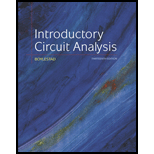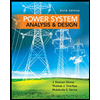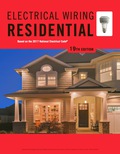
Introductory Circuit Analysis (13th Edition)
13th Edition
ISBN: 9780133923605
Author: Robert L. Boylestad
Publisher: PEARSON
expand_more
expand_more
format_list_bulleted
Concept explainers
Textbook Question
Chapter 3, Problem 20P
The resistance of an aluminum bus-bar is
Expert Solution & Answer
Want to see the full answer?
Check out a sample textbook solution
Students have asked these similar questions
a. A silicon sample maintained at room temperature is uniformly doped with ND=10¹6/cm³
donors. Calculate the resistivity of the sample.
b. The silicon sample of part (a) is "compensated" by adding NA=1016/cm³ acceptors. Calculate
the resistivity of the compensated sample.
c. Compute the resistivity of intrinsic silicon at room temperature.
d. A 500 resistor is to be made from a bar-shaped piece of n-type Si. The bar has a cross
sectional area of 102 cm² and a current-carrying length of 1 cm. Determine the doping
required.
μn or μp (cm²/V-sec)
1000
Electrons
Holes
NA or ND (cm³)
1x1014
Мет
Mp
(cm2V-sec)
1358
461
2
1357 460
100
5
1352
459
1 x 1015
1345
458
2
1332
455
5
1298
448
1 x 1016....
1248 437
2
1165 419
5
986 378
1 x 1017
801
331
10
1014
1015
1016
NA or ND (cm-³)
1017
1018
Silicon
T = 300 K
4. Two different silicon samples maintained at 300K are characterized by the energy band diagrams.
Answer the questions that follow after choosing a specific diagram for analysis.
a) Do equilibrium conditions prebail? How do you know?
b) Sketch the electrostatic potential (V) inside the semiconductor as a function of x.
c) Sketch the electric field (ε) inside the semiconductor as a function of x.
EF
Ec
E₁
Ev
E₁
EF
Ev
X
X
0
L/2
L
0
L/2
L
3.
See BOTH images to answer correctly thx
Chapter 3 Solutions
Introductory Circuit Analysis (13th Edition)
Ch. 3 - Convert the following to mils: 0.2Â in. 1/32Â in....Ch. 3 - Calculate the area in circular mils (CM) of wires...Ch. 3 - Prob. 3PCh. 3 - What is the resistance of a copper wire 200 ft...Ch. 3 - What is the area in circular mils of an aluminum...Ch. 3 - A 2.2 resistor is to be made of nichrome wire. If...Ch. 3 - What is the diameter in inches of a copper wire...Ch. 3 - A wire 1000 ft long has a resistance of 0.5 and an...Ch. 3 - A contractor is concerned about the length of...Ch. 3 - What is the cross-sectional area in circular mile...
Ch. 3 - Prob. 11PCh. 3 - Determine the increase in resistance of a copper...Ch. 3 - What is the new resistance level of a copper wire...Ch. 3 - In construction the two most common wires employed...Ch. 3 - Compare the area of a #12 wire with the area of a...Ch. 3 - Compare the area of a #20 hookup wire to a #10...Ch. 3 - For the system in Fig. 3.46, the resistance of...Ch. 3 - From Table 3.2, determine the maximum permissible...Ch. 3 - The resistance of a copper wire is 2 at room...Ch. 3 - The resistance of an aluminum bus-bar is 0.02 at...Ch. 3 - The resistance of a copper wire is 1.2 at room...Ch. 3 - The resistance of a copper wire is 25m at a...Ch. 3 - The resistance of a copper wire is 1 at 20C (room...Ch. 3 - If the resistance of 1000 ft of wire is about 1 at...Ch. 3 - Verify the value of 20 for copper in Table 3.4 by...Ch. 3 - Prob. 26PCh. 3 - Prob. 27PCh. 3 - A 22 wire-wound resistor is rated at +200PPM for a...Ch. 3 - A 100 wire-wound resistor is rated at +100PPM for...Ch. 3 - What is the approximate increase in size from a 1...Ch. 3 - If the resistance between the outside terminals of...Ch. 3 - If the wiper arm of a linear potentiometer is...Ch. 3 - Show the connections required to establish 4k...Ch. 3 - Find the range in which a resistor having the...Ch. 3 - Find the color code for the following 10%...Ch. 3 - Is there an overlap in coverage between 20...Ch. 3 - Given a resistor coded yellow, violet, brown,...Ch. 3 - How would Fig. 3.26(a) change if the resistors of...Ch. 3 - Find the value of the following surface mount...Ch. 3 - Find the conductance of each of the following...Ch. 3 - Find the conductance of 1000 ft of #12 AWG wire...Ch. 3 - Find the conductance of a 10,20 and 100 resistor...Ch. 3 - The conductance of a wire is 100 S. If the area of...Ch. 3 - Why do you never apply an ohmmeter to a live...Ch. 3 - How would you check the status of a fuse with an...Ch. 3 - How would you determine the on and off states of a...Ch. 3 - How would you use an ohmmeter to check the status...Ch. 3 - Using metric units, determine the length of a...Ch. 3 - Repeat Problem 11 using metric units; that is,...Ch. 3 - If the sheet resistance of a tin oxide sample is...Ch. 3 - Determine the width of a carbon resistor having a...Ch. 3 - Derive the conversion factor between (CM-/ft) and...Ch. 3 - In your own words, review what you have learned...Ch. 3 - Visit your local library and find a table listing...Ch. 3 - Find at least one article on the application of...Ch. 3 - Using the required 1MA/cm2 density level for...Ch. 3 - Research the SQUID magnetic field detector and...Ch. 3 - Find the resistance of the thermistor having the...Ch. 3 - Using the characteristics of Fig. 3.38, determine...Ch. 3 - Referring to Fig. 3.40(a), find the terminal...
Knowledge Booster
Learn more about
Need a deep-dive on the concept behind this application? Look no further. Learn more about this topic, electrical-engineering and related others by exploring similar questions and additional content below.Similar questions
- a. An average hole drift velocity of 103 cm/sec results when 2V is applied across a 1 cm long semiconductor bar. What is the hole mobility inside the bar? b. Name the two dominant carrier scattering mechanisms in nondegeneratedly doped semiconductors of device quality. c. For a give semiconductor the carrier mobilities in intrinsic material are (choose one: higher than, lower than, the same as) those in heavily doped material. Briefly explain why the mobilites in intrinsic material are (chosen answer) those in heavily doped material.arrow_forwardFind the steady-state expression for vo(t) in the following circuit if vg (t) = 64 cos(8000t) V. 31.25 nF HE + Vg + - 2 ΚΩ Vo 500 mHarrow_forwardUse PSpice to model the differential amplifier circuit shown in Fig. 4 in DIBO mode (double input balanced output). Use 2N3904 BJTs and use appropriate values for resistors (you can choose the values that will not lead to excessive gain and saturation) to demonstrate that the circuit provides differential amplification. Use Vcc = 5 and Vee = 5. Use a pair of sinusoids with opposing polarity (180 degree phase shift) as the inputs to the differential amplifier. Recall from the theory ic is needed to compute re. Make sure that the conditions set in the analysis of DIBO circuit are satisfied. Assume Rs1 = Rs2 50 Ω. Does your simulation match the theoretical gain? Explain any differences.arrow_forward
- Derive the expression for the voltage gain of DIBO differential amplifier using AC analysis.arrow_forwardConsider the following circuit. + - 1.2 ΚΩ ig (1) vo ΣΕ ΚΩ € 50 nF 200 mH a) [6 pts] The frequency of the source current in the circuit is adjusted until vo is in phase with ig. What is the value of o in radians per second? (Hint: if vo is in phase with ig, the phase of total impedance must be zero (Ztot = vol ig), which means the phase of total admittance is zero. It will be easy to work with admittance in this question because the components are in parallel.) b) [2 pts] What is the total impedance at the frequency found in (a)? c) [2 pts] Ifig=2.5 cosoot mA (where o is the frequency found in [a]), what is the steady-state expression for vo?arrow_forwardConsider the following circuit with ig (t) = 200 cos(5000t) mA. 240 ΩΣ + 80 2: 2.5 µF 48 mH a) [3 pts] Obtain and draw the frequency-domain circuit. b) [3 pts] Use the current division to find the current flowing through the 240 2 resistor. c) [3 pts] Then calculate Vo in phasor form. d) [1 pts] Write the steady-state expression for vo(t).arrow_forward
- Q-Draw a sample and hold electronic circuit using op-amp then explain its operation. I hope the solution is from a human being and not from intelligencearrow_forwardDesign an AC-coupled (input and output) amplifier with a gain of -8 which has identical 3 dB corner frequencies of 10 kHz for high pass coupling at the input and output. Assume a power supply of 5 volts.arrow_forwardFind Laplace inverse for -25 -1 e S-1arrow_forward
- This question and its solution. Is the solution correct? If the solution is correct, assume that let R2 = 20 and a=500 . If it is wrong, solve it in your own way, away from the sources, and explain to me in detail with a pen and paper, please.arrow_forwardcan you compute the values inside the blue circles using the data from the plan above them? Please disregard the values (data/numbers) inside the circles.arrow_forwardThe average output voltage is found from Vac = = 2 2π/6 3√3 π -V #16 m √√3V™ cos ot d (ot) 0 = 1.654Vm m where Vm, is the peak phase voltage. I want detailed integration steps and how you reached this result.arrow_forward
arrow_back_ios
SEE MORE QUESTIONS
arrow_forward_ios
Recommended textbooks for you
 Power System Analysis and Design (MindTap Course ...Electrical EngineeringISBN:9781305632134Author:J. Duncan Glover, Thomas Overbye, Mulukutla S. SarmaPublisher:Cengage Learning
Power System Analysis and Design (MindTap Course ...Electrical EngineeringISBN:9781305632134Author:J. Duncan Glover, Thomas Overbye, Mulukutla S. SarmaPublisher:Cengage Learning Delmar's Standard Textbook Of ElectricityElectrical EngineeringISBN:9781337900348Author:Stephen L. HermanPublisher:Cengage Learning
Delmar's Standard Textbook Of ElectricityElectrical EngineeringISBN:9781337900348Author:Stephen L. HermanPublisher:Cengage Learning EBK ELECTRICAL WIRING RESIDENTIALElectrical EngineeringISBN:9781337516549Author:SimmonsPublisher:CENGAGE LEARNING - CONSIGNMENT
EBK ELECTRICAL WIRING RESIDENTIALElectrical EngineeringISBN:9781337516549Author:SimmonsPublisher:CENGAGE LEARNING - CONSIGNMENT Electricity for Refrigeration, Heating, and Air C...Mechanical EngineeringISBN:9781337399128Author:Russell E. SmithPublisher:Cengage Learning
Electricity for Refrigeration, Heating, and Air C...Mechanical EngineeringISBN:9781337399128Author:Russell E. SmithPublisher:Cengage Learning

Power System Analysis and Design (MindTap Course ...
Electrical Engineering
ISBN:9781305632134
Author:J. Duncan Glover, Thomas Overbye, Mulukutla S. Sarma
Publisher:Cengage Learning

Delmar's Standard Textbook Of Electricity
Electrical Engineering
ISBN:9781337900348
Author:Stephen L. Herman
Publisher:Cengage Learning

EBK ELECTRICAL WIRING RESIDENTIAL
Electrical Engineering
ISBN:9781337516549
Author:Simmons
Publisher:CENGAGE LEARNING - CONSIGNMENT

Electricity for Refrigeration, Heating, and Air C...
Mechanical Engineering
ISBN:9781337399128
Author:Russell E. Smith
Publisher:Cengage Learning
What is a Thyristor? - A Galco TV Tech Tip; Author: GalcoTV;https://www.youtube.com/watch?v=LBb_Qz7J3zA;License: Standard Youtube License